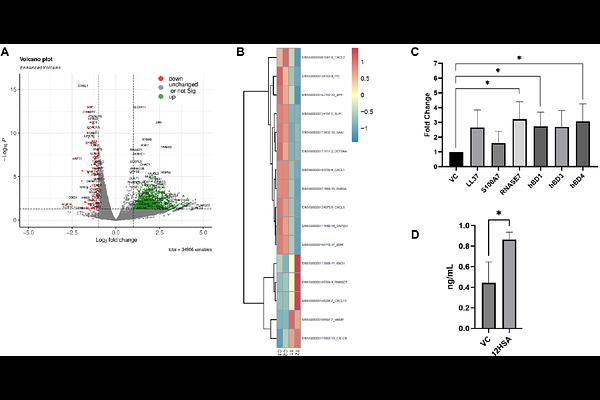12-Hydroxystearic acid induces epidermal keratinocytes to secrete antimicrobial peptides that are potent inhibitors of viral infection.

12-Hydroxystearic acid induces epidermal keratinocytes to secrete antimicrobial peptides that are potent inhibitors of viral infection.
Gangte, O. M.; Nandy, K.; Bhatt, T.; Grewall, A.; Kulkarni, A.; Garg, V.; Ashok, A.; Mukherjee, S.; Wasker, M.; Pathak, S.; Kumar, N.; Sanzgiri, V.; Jayasekera, H.; Ghatlia, N.; Majumdar, A.; Jamora, C.
AbstractEpidermal keratinocytes produce antimicrobial peptides (AMPs) that serve as a crucial component of the skin\'s innate immune barrier. These peptides effectively target a broad spectrum of pathogenic microorganisms while preserving commensal microbiota essential for skin barrier homeostasis and overall skin health. Regulating the release of these AMPs presents a promising approach to enhancing the skin barrier\'s defense mechanisms with minimal side effects. We have identified 12-hydroxystearic acid (12-HSA) as a potent stimulator of AMP secretion from primary epidermal keratinocytes. Mechanistic investigations revealed that, akin to bacterial stimulation,12-HSA induces AMP release through the downregulation of caspase-8, which subsequently activates the inflammasome. Notably, we discovered that 12-HSA mediates caspase-8 downregulation via the acute activation of DNA methyltransferase 3A (DNMT3A), leading to transcriptional silencing of the caspase-8 locus. Importantly, 12-HSA is widely utilized in the cosmetic industry for its several skin beneficial properties including hydration and emolliency. Our findings suggest that this compound can be leveraged to enhance innate immune defenses in the skin, effectively mobilizing stored AMPs from keratinocytes to counteract microbial threats. This discovery highlights the potential for 12-HSA as a novel agent in dermatological applications aimed at fortifying skin barrier immunity.